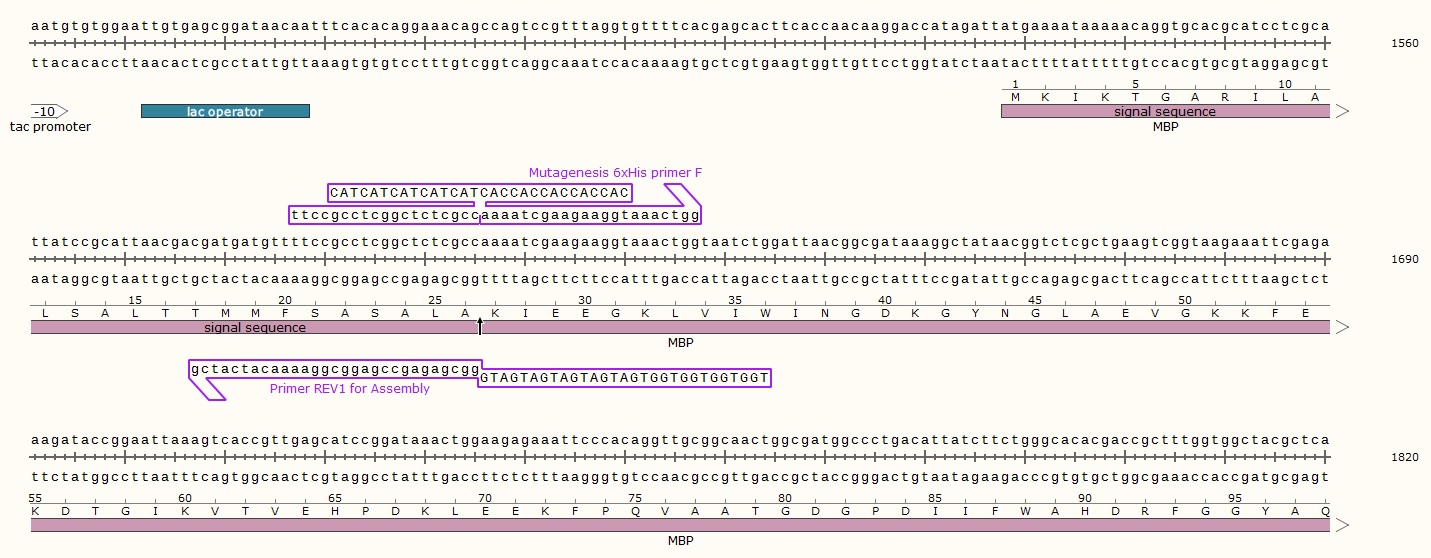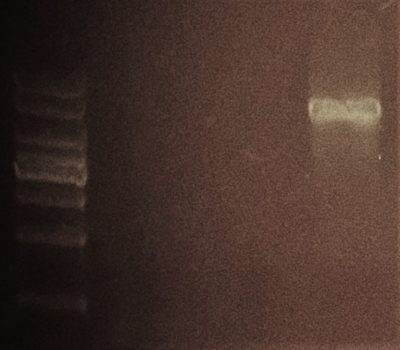Insertion of a 10xHis Tag by Site-Directed Mutagenesis
PCR Success Story #11Project Description
Large 10xHis Insertion by Site-Directed Mutagenesis
This project originated from a customer asking us advice on the experimental design for accomplishing an Insertion by Site-Directed Mutagenesis. Their goal was to insert the large repetitive 10xHis Tag in their protein of interest (STb). Their previous attempts had failed. Their plasmid actually codes for a pMAL-STb fusion protein. The researcher’s lab is located at the Faculté de Médecine Véétérinaire de l’Université de Montréal (FMV) in St-Hyacinthe. No restriction sites were available + or – 100 bp of where the 10xHis tag needed to be inserted. The tag also needed to be inserted after MBP’s (Maltose Binding Protein encoded in pMAL) signal peptide cleavage site to ensure detection after protein expression.
We designed the mutagenesis primers and a complete protocol for the researcher. We used the Transgen Biotech’s Fast Mutagenesis System strategy to perform the Insertion by Site-Directed Mutagenesis.
Project Details
Client: Faculté de Médecine Vétérinaire de l’Université de Montréal
Date: June 4th, 2016
Type of experiment: Insertion of a 10xHis Tag by Site-Directed Mutagenesis
DNA Polymerase: TransStart FastPfu High-Fidelity DNA Polymerase & Fast Mutagenesis System
Competitor: None
Site-Directed insertion strategy of the 10xHis tag
The Fast Mutagenesis System utilizes a partially overlapping primer design, which enables semi-exponential PCR amplification. Also, the mutation/insertion is inserted in the middle of the forward primer and at the extreme 5′ end of the reverse primer, making the PCR reaction with 2xTransStart FastPfu Supermix easier for high-fidelity DNA polymerases. The PCR product is then treated with DMT (Dpn I) restriction enzyme to digests methylated template DNA, then transformed into DMT Chemically Competent Cells. All reagents are either included in the Fast Mutagenesis System or can be bought separately.
Sequence and primer design for site-directed insertion of 10xHis tag
The pMAL vector encodes for MBP (Maltose-Binding Protein). pMAL-STb codes for a MBP-STb fusion protein enabling the researcher to express and purify STb in heterologous cells. For extra detection, the researcher wanted to add a 10xHis tag and use RevMAb’s 6xHis or 10xHis Monoclonal antibody for detection. MBP contains a signal peptide in its N-terminus. In order to keep the 10xHis tag intact following signal peptide cleavage, we designed the insertion to be targeted after the signal peptide cleavage site (black arrow).
Primer FWD SP-10xHis-MBP :
ttccgcctcggctctcgccCATCATCATCATCATCACCACCACCACCAcaaaatcgaagaaggtaaactgg
Gene-specific 3′ end (bold): Tm = 52°C and 39% GC
Primer REV SP-10xHis-MBP :
TGGTGGTGGTGGTGATGATGATGATGATGggcgagagccgaggcggaaaacatcatcg
Gene-specific 3′ end (bold): Tm = 70°C and 62% GC
Mutagenesis PCR reaction setup:
- H2O : 10.5 ul
- 2x TransStart FastPfu Supermix 12.5 ul
- Forward primer (10 uM): 0.5 ul (200 nM final)
- Reverse primer (10 uM) : 0.5 ul (200 nM final)
- pMAL-STb plasmid : 1 ul (10 ng)
PCR cycling for site-directed mutagenesis :
- Denaturation: 120s at 94 °C
- 25 x
- Denaturation: 20s at 94 °C
- Annealing: 40s at 50 °C
- Extension: 320s at 68 °C
- Final extension: 600s at 72 °C
Successful PCR Amplification with FastPfu
10 ul of the PCR reaction was loaded on a 0.8% agarose gel.
pMAL-STb plasmid size is approximately 6.35 kb. Our DNA staining dye retards DNA migration when a large amount of DNA is loaded on the gel. More DNA means more molecules interact with the dye and we observe slightly higher band sizes. We therefore estimate that the amplicon is of the correct size.
Available Products for Insertion by Site-Directed Mutagenesis
-
DMT Competent Cell (DpnI+) – CD511
$136.00 – $212.00 CAD -
DMT Enzyme ( Dpn I ) – GD111
$72.00 CAD -
Fast MultiSite Mutagenesis System – FM201
$600.00 CAD -
Fast Mutagenesis System – FM111
$240.00 – $415.00 CAD -
Ju™ DNA Assembly Mix for Cloning and Mutagenesis – CB-JU101
$125.00 – $280.00 CAD - Sale!
KLD Mix for Back-to-Back Site-Directed Mutagenesis
$110.00 – $464.00 CAD
Want PCR to be easier for you too?
Put us in charge of optimizing PCR conditions for you. It’s FREE !





